Microwave Treatments and Their Effects on Selected Properties of Portuguese Pinus pinaster Aiton. and Eucalyptus globulus Labill. Wood
Abstract
1. Introduction
2. Materials and Methods
2.1. Sample Preparation
2.2. MW Treatment
2.3. Evaluation of Water Impregnability
2.4. Determination of Mechanical Properties
2.5. Statistical Analysis
3. Results and Discussion
3.1. MW Treatment, Visual Modification, and Density
3.2. Water Impregnability
3.3. Mechanical Properties
4. Conclusions
- Each wood species behaved differently under the same MW power and continuous exposure time in terms of total MW drying time, average drying rate, and efficiency. The pine samples had higher drying rates compared with the eucalyptus specimens.
- For both wood species, the higher the MW treatment power, the more expressive the distortions in the cross-section of the samples. In addition, as a consequence of the possible damage that occurred in the microstructure of the wood, a reduction in the densities of the samples was identified as the MW power increased, with the eucalyptus samples being more affected than the pine samples.
- The MW treatment remarkably improved the water impregnability of the samples. However, in most cases, the better the improvements in water uptake, the higher the reductions in strength and stiffness.
- Under an MW treatment power of 700 W and a 2 min cycle time, the MOR and MOE values of MW-treated maritime pine samples were statistically equivalent to the ones from the control group, and they improved the water uptake around four times.
- For the eucalypt groups EG_1200W_2min and EG_700W_2min, the average reductions of MOR were 26 and 23% and of MOE were 32 and 15% in relation to the control samples, respectively, with an average increase of two times in the water impregnability.
Author Contributions
Funding
Data Availability Statement
Acknowledgments
Conflicts of Interest
References
- Matthias, J.; Mahendran, A.R.; Gindl-Altmutter, W.; Bliem, P.; Konnerth, J.; Müller, U.; Veigel, S. The strength and stiffness of oriented wood and cellulose-fibre materials: A review. Prog. Mater. Sci. 2022, 125, 100916. [Google Scholar] [CrossRef]
- Monteiro, S.R.S.; Martins, C.; Dias, A.M.P.G.; Cruz, H. Mechanical performance of glulam products made with Portuguese poplar. Eur. J. Wood Wood Prod. 2020, 78, 1007–1015. [Google Scholar] [CrossRef]
- Santos, J.; Pereira, J.; Ferreira, N.; Paiva, N.; Ferra, J.; Magalhães, F.D.; Martins, J.M.; Dulyanska, Y.; Carvalho, L.H. Valorisation of non-timber by-products from maritime pine (Pinus pinaster, Ait) for particleboard production. Ind. Crops Prod. 2021, 168, 113581. [Google Scholar] [CrossRef]
- Martins, C.; Dias, A.M.P.G.; Cruz, H. Bonding performance of Portuguese Maritime pine glued laminated timber. Constr. Build. Mater. 2019, 223, 520–529. [Google Scholar] [CrossRef]
- Águas, A.; Ferreira, A.; Maia, P.; Fernandes, P.M.; Roxo, L.; Keizer, J.; Silva, J.S.; Rego, F.C.; Moreira, F. Natural establishment of Eucalyptus globulus Labill. in burnt stands in Portugal. Ecol. Manag. 2014, 323, 47–56. [Google Scholar] [CrossRef]
- Suleimana, A.; Peixoto, B.C.; Branco, J.M.; Camões, A. Experimental Evaluation of Glulam Made from Portuguese Eucalyptus. Appl. Sci. 2023, 13, 6866. [Google Scholar] [CrossRef]
- Vaz, A.; Coelho, J.; Costa, V.; Maloney, T.; Phiri, J.; Pinto, P.; Sousa, A.M.; Simões, R. Effect of enzymatic treatment on Eucalyptus globulus vessels passivation. Sci. Rep. 2023, 13, 2832. [Google Scholar] [CrossRef]
- Gaspar, F.; Cruz, H.; Gomes, A.; Nunes, L. Production of glued laminated timber with copper azole treated maritime pine. Eur. J. Wood Wood Prod. 2010, 68, 207–218. [Google Scholar] [CrossRef][Green Version]
- Dias, A.M.A.; Santos, P.G.G.; Dias, A.M.P.G.; Silvestre, J.D.; Brito, J. Life cycle assessment of a preservative treated wooden deck. Wood Mater. Sci. Eng. 2022, 17, 502–512. [Google Scholar] [CrossRef]
- ICNF. Inventário Florestal Nacional (IFN6)—Principais resultados—Relatório sumário. 2019. Available online: https://www.icnf.pt/api/file/doc/c8cc40b3b7ec8541 (accessed on 13 January 2023).
- Lopes, A.F.; Batista, E.; Hilário, S.; Santos, L.; Alves, A. Occurrence of Diaporthe species in Eucalyptus globulus, Pinus pinaster and Quercus suber in Portugal. For. Pathol. 2021, 51, e12674. [Google Scholar] [CrossRef]
- Qin, Y.; Long, D.; Li, J. Research Progress in the Chemical Modification of Eucalyptus. IOP Conf. Ser. Mater. Sci. Eng. 2019, 677, 022114. [Google Scholar] [CrossRef]
- Franke, S.; Marto, J. Investigation and analysis of press glued connections for timber structures. In Proceedings of the World Conference on Timber Engineering—WCTE 2014, Quebec City, Canada, 10–14 August 2014; Available online: https://www.researchgate.net/publication/312198486 (accessed on 27 July 2023).
- Seng Hua, L.; Wei Chen, L.; Antov, P.; Kristak, L.; Md Tahir, P. Engineering Wood Products from Eucalyptus spp. Adv. Mater. Sci. Eng. 2022, 2022, 8000780. [Google Scholar] [CrossRef]
- Nasswettrová, A.; Šmíra, P.; Zejda, J.; Nikl, K.; Sebera, V. Axial Permeability of Beech Wood Treated by Microwave Heating for Distilled Water. Wood Res. 2014, 59, 25–38. Available online: https://www.woodresearch.sk/wr/201401/03.pdf (accessed on 14 August 2023).
- Hess, D.; Pařil, P.; Dömény, J.; Baar, J. Permeability and mechanical behaviour of microwave pre-treated Norway spruce ripewood. Wood Res. 2021, 66, 569–581. [Google Scholar] [CrossRef]
- Harris, G.A.; Torgovnikov, G.; Vinden, P.; Brodie, G.I.; Shaginov, A. Microwave pretreatment of backsawn messmate boards to improve drying quality: Part 1. Dry Technol 2008, 26, 579–584. [Google Scholar] [CrossRef]
- Kol, H.Ş.; Çayır, B. The effects of increasing preservative uptake by microwave pre-treatment on the microstructure and mechanical properties of Oriental spruce wood. Wood Mater. Sci. Eng. 2023, 18, 732–738. [Google Scholar] [CrossRef]
- Beikircher, W.; Lux, C.; Saxer, A. Microwave pretreatment of Norway spruce (Picea abies) for preservative treatment. In Proceedings of the World Conference on Timber Engineering—WCTE 2012, Auckland, New Zealand, 15–19 July 2012. [Google Scholar]
- Nasswettrová, A.; Nikl, K.; Zejda, J.; Klepárník, J. The Analysis and Optimization of High-Frequency Electromagnetic Field Homogeneity by Mechanical Homogenizers within the Space of Wood Microwave Heating Device. Wood Res. 2013, 58, 11–24. Available online: https://www.woodresearch.sk/wr/201301/02.pdf (accessed on 13 August 2013).
- Samani, A.; Ganguly, S.; Kanyal, R.; Tripathi, S. Effect of microwave pre-treatment on preservative retention and treatability of Melia composita wood. J. For. Sci. 2019, 65, 391–396. [Google Scholar] [CrossRef]
- Poonia, P.K.; Tripathi, S. Effect of microwave heating on pH and termite resistance of Pinus roxburghii Wood. Maderas Cienc. Tecnol. 2018, 20, 499–504. [Google Scholar] [CrossRef]
- Tahmasebi, A.; Yu, J.; Han, Y.; Zhao, H.; Bhattacharya, S. A kinetic study of microwave and fluidized-bed drying of a Chinese lignite. Chem. Eng. Res. Des. 2014, 92, 54–65. [Google Scholar] [CrossRef]
- Torgovnikov, G.; Vinden, P. High-intensity microwave wood modification for increasing permeability. Prod. J. 2009, 59, 84–92. [Google Scholar]
- Gašparík, M.; Barcík, Š. The Suitability of Microwave Heating from the Perspective of Practical Use in Construction and Building Industry. Wood Res. 2014, 59, 401–410. Available online: https://www.woodresearch.sk/wr/201403/03.pdf (accessed on 13 March 2021).
- Thybring, E.E.; Fredriksson, M.; Zelinka, S.L.; Glass, S.V. Water in Wood: A Review of Current Understanding and Knowledge Gaps. Forests 2022, 13, 2051. [Google Scholar] [CrossRef]
- Oloyede, A.; Groombridge, P. The Influence of microwave heating on the mechanical properties of wood. J. Mater. Process. Technol. 2000, 100, 67–73. [Google Scholar] [CrossRef]
- Metaxas, A.C.; Meredith, R.J. Industrial Microwave Heating, 3rd ed.; Short Run Press Ltd.: Exeter, UK, 2008; Volume 24. [Google Scholar] [CrossRef]
- Torgovnikov, G.; Vinden, P. Microwave wood modification technology and its applications. Prod. J. 2010, 60, 173–182. [Google Scholar] [CrossRef]
- Zemiar, J.; Makoviny, I.; Palko, M.; Gasparik, M. Temperature and moisture profiles at microwave heating of wood. Ann. Wars. Univ. Life Sci. SGGW For. Wood Technol. 2009, 67, 283–288. [Google Scholar]
- Xiao, H.; Lin, L.; Fu, F. Temperature characteristics of wood during microwave treatments. J. Res. 2018, 29, 1815–1820. [Google Scholar] [CrossRef]
- He, S.; Leng, W.; Chen, Y.; Li, H.; Li, J.; Wu, Z.; Xiao, Z. Microwave Drying of Scots Pine Lumber: Structure Changes, Its Effect on Liquid Permeability. J. Renew. Mater. 2023, 11, 321–331. [Google Scholar] [CrossRef]
- Jang, E.S.; Kang, C.W. An experimental study on efficient physical wood modification for enhanced permeability—Focusing on ultrasonic and microwave treatments. Wood Mater. Sci. Eng. 2022, 18, 446–453. [Google Scholar] [CrossRef]
- Kol, H.Ş.; Çayır, B. Increasing the Impregnability of Oriental Spruce Wood via Microwave Pretreatment. Bioresources 2021, 16, 2513–2523. [Google Scholar]
- He, S.; Lin, L.; Fu, F.; Zhou, Y.; Fan, M. Microwave treatment for enhancing the liquid permeability of Chinese fir. Bioresources 2014, 9, 1914–1923. [Google Scholar] [CrossRef]
- Peres, M.L.; Delucis, R.A.; Gatto, D.A.; Beltrame, R. Mechanical behavior of wood species softened by microwave heating prior to bending. Eur. J. Wood Wood Prod. 2015, 74, 143–149. [Google Scholar] [CrossRef]
- Hermoso, E.; Vega, A. Effect of microwave treatment on the impregnability and mechanical properties of Eucalyptus globulus wood. Maderas Cienc. Tecnol. 2016, 18, 55–64. [Google Scholar] [CrossRef]
- Ouertani, S.; Koubaa, A.; Azzouz, S.; Bahar, R.; Hassini, L.; Belghith, A. Microwave drying kinetics of jack pine wood: Determination of phytosanitary efficacy, energy consumption, and mechanical properties. Eur. J. Wood Wood Prod. 2018, 76, 1101–1111. [Google Scholar] [CrossRef]
- Balboni, B.M.; Ozarska, B.; Garcia, J.N.; Torgovnikov, G. Microwave treatment of Eucalyptus macrorhyncha timber for reducing drying defects and its impact on physical and mechanical wood properties. Eur. J. Wood Wood Prod. 2018, 76, 861–870. [Google Scholar] [CrossRef]
- Ramananantoandro, T.; Ramanakoto, M.F.; Rajoelison, G.L.; Randriamboavonjy, J.C.; Rafidimanantsoa, H.P. Influence of tree species, tree diameter and soil types on wood density and its radial variation in a mid-altitude rainforest in Madagascar. Ann. Sci. 2016, 73, 1113–1124. [Google Scholar] [CrossRef]
- Machado, J.S.; Louzada, J.L.; Santos, A.J.A.; Nunes, L.; Anjos, O.; Rodrigues, J.; Simões, R.M.S.; Pereira, H. Variation of wood density and mechanical properties of blackwood (Acacia melanoxylon R. Br.). Mater. Des. 2014, 56, 975–980. [Google Scholar] [CrossRef]
- Ramage, M.H.; Burridge, H.; Busse-Wicher, M.; Fereday, G.; Reynolds, T.; Shah, D.U.; Wu, G.; Yu, L.; Fleming, P.; Densley-Tingley, D.; et al. The wood from the trees: The use of timber in construction. Renew. Sustain. Energy Rev. 2017, 68, 333–359. [Google Scholar] [CrossRef]
- Mihailovic, V.; Miric-Milosavljevic, M.; Djurkovic, M.; Mladenovic, G.; Milosevic, M.; Trajkovic, I. Loading rate effects on MOE and MOR distributions in testing of small clear beech wood specimen. Bioresources 2022, 17, 1818–1835. [Google Scholar] [CrossRef]
- Torgovnikov, G.; Vinden, P.; Balbony, B. Microwave Conversion of Plantation Grown Blue Gum (Eucalyptus globulues L’Herit) Wood to Torgvin and Impregnation with a Metal Alloy. J. Mater. Sci. Eng. Adv. Technol. 2015, 11, 1–19. [Google Scholar] [CrossRef]
- ISO 3129:2019; Wood—Sampling Methods and General Requirements for Physical and Mechanical Testing of Small Clear Wood Specimens. International Organization for Standardization: Geneva, Switzerland, 2019.
- ISO 13061-1:2014; Physical and Mechanical Properties of Wood—Test Methods for Small Clear Wood Specimens—Part 1: Determination of Moisture Content for Physical and Mechanical Tests. International Organization for Standardization: Geneva, Switzerland, 2014.
- Dömény, J.; Koiš, V.; Dejmal, A. Microwave Radiation Effect on Axial Fluid Permeability in False Heartwood of Beech (Fagus sylvatica L.). Bioresources 2014, 9, 372–380. [Google Scholar] [CrossRef][Green Version]
- Antti, A.L. Microwave drying of pine and spruce. Holz Als. Roh Und Werkst. 1995, 53, 333–338. [Google Scholar] [CrossRef]
- ISO 13061-3:2014; Physical and Mechanical Properties of Wood—Test Methods for Small Clear Wood Specimens—Part 3: Determination of Ultimate Strength in Static Bending. International Organization for Standardization: Geneva, Switzerland, 2014.
- ISO 13061-4:2014; Physical and Mechanical Properties of Wood—Test Methods for Small Clear Wood Specimens—Part 4: Determination of Modulus of Elasticity in Static Bending. International Organization for Standardization: Geneva, Switzerland, 2014.
- ISO 13061-2:2014; Physical and Mechanical Properties of Wood—Test Methods for Small Clear Wood Specimens—Part 2: Determination of Density for Physical and Mechanical tests. International Organization for Standardization: Geneva, Switzerland, 2014.
- Minitab. Software Minitab 18, 2018. Available online: https://www.minitab.com/en-us/?locale=en-US (accessed on 29 June 2023).
- Li, Z.; Gao, X.; Lu, D. Correlation analysis and statistical assessment of early hydration characteristics and compressive strength for multi-composite cement paste. Constr. Build. Mater. 2021, 310, 125260. [Google Scholar] [CrossRef]
- Nowicki, J.; Hebda-Sobkowicz, J.; Zimroz, R.; Wyłomańska, A. Dependency measures for the diagnosis of local faults in application to the heavy-tailed vibration signal. Appl. Acoust. 2021, 178, 107974. [Google Scholar] [CrossRef]
- Wilson, J.B.; Sakimoto, E.T. Gate-To-Gate Life-Cycle Inventory of Softwood Plywood Production. Wood Fiber. Sci. 2006, 37, 58–73. [Google Scholar]
- Bergman, R.; Bergman, R.D.; Bowe, S.A. Environmental impact of producing hardwood lumber using life-cycle inventory. In Proceedings of the 10th International IUFRO Division 5, Wood Drying Conference, Orono, ME, USA, 26–30 August 2007; pp. 180–185. [Google Scholar] [CrossRef]
- Cǒté, W.A., Jr. Structural Factors Affecting the Permeability of Wood. J. Polym. Sci. Part C Polym. Symp. 1963, 2, 231–242. [Google Scholar] [CrossRef]
- Panigrahi, S.; Kumar, S.; Panda, S.; Borkataki, S. Effect of permeability on primary processing of wood. J. Pharmacogn. Phytochem, 2018, 7, 2593–2598. Available online: http://www.timber.lk (accessed on 19 October 2022).
- Jang, E.S.; Yuk, J.H.; Kang, C.W. An experimental study on change of gas permeability depending on pore structures in three species (hinoki, Douglas fir, and hemlock) of softwood. J. Wood Sci. 2020, 66, 78. [Google Scholar] [CrossRef]
- He, X.; Xiong, X.; Xie, J.; Li, Y.; Wei, Y.; Quan, P.; Mou, Q. Effect of microwave pretreatment on permeability and drying properties of wood. Bioresources 2017, 12, 3850–3863. [Google Scholar] [CrossRef]
- Leiker, M.; Adamska, M.A. Energy efficiency and drying rates during vacuum microwave drying of wood. Holz Als Roh Und Werkst. 2004, 62, 203–208. [Google Scholar] [CrossRef]
- Vongpradubchai, S.; Rattanadecho, P. The microwave processing of wood using a continuous microwave belt drier. Chem. Eng. Process Process. Intensif. 2009, 48, 997–1003. [Google Scholar] [CrossRef]
- Mascarenhas, F.J.R.; Dias, A.M.P.G.; Christoforo, A.L.; Simões, R.M.S.; Cunha, A.E.P. Effect of Microwave Treatment on Drying and Water Impregnability of Pinus Pinaster and Eucalyptus globulus. Maderas Cienc. Tecnol. 2023, 25, 1–21. [Google Scholar] [CrossRef]
- Terziev, N.; Daniel, G.; Torgovnikov, G.; Vinden, P. Effect of microwave treatment on the wood structure of Norway spruce and radiata pine. Bioresources 2020, 15, 5616–5626. [Google Scholar] [CrossRef]
- Kumar, P.P.; Kumar, S.H.; Sihag, K.; Tripathi, S. Effect of microwave treatment on longitudinal air permeability and preservative uptake characteristics of chir pine wood. Maderas Cienc. Tecnol. 2016, 18, 125–132. [Google Scholar] [CrossRef]
- Kumar, P.P.; Tripathi, S.; Sihag, K.; Kumar, S. Effect of microwave treatment on air permeability and preservative impregnation of Eucalyptus tereticornis wood. J. Indian Acad. Wood Sci. 2015, 12, 89–93. [Google Scholar] [CrossRef]
- Koiš, V.; Dömény, J.; Tippner, J. Microwave device for continuous modification of wood. Bioresources 2014, 9, 3025–3037. [Google Scholar] [CrossRef][Green Version]
- Thelandersson, S.; Larsen, H.J. Timber Engineering; John Wiley & Sons Ltd.: Hoboken, NJ, USA, 2003; Volume 1. [Google Scholar]
- Fan, Z.; Peng, L.; Liu, M.; Feng, Y.; He, J.; Wu, S. Analysis of influencing factors on sound absorption capacity in microwave-treated Pinus radiata wood. Eur. J. Wood Wood Prod. 2022, 80, 985–995. [Google Scholar] [CrossRef]
- Nasswettrová, A.; Šmíra, P.; Křivánková, S. Effect of microwave heating on compressive strength of beech wood (Fagus sylvatica L.) parallel to grain. Dry. Technol. 2016, 34, 1011–1022. [Google Scholar] [CrossRef]
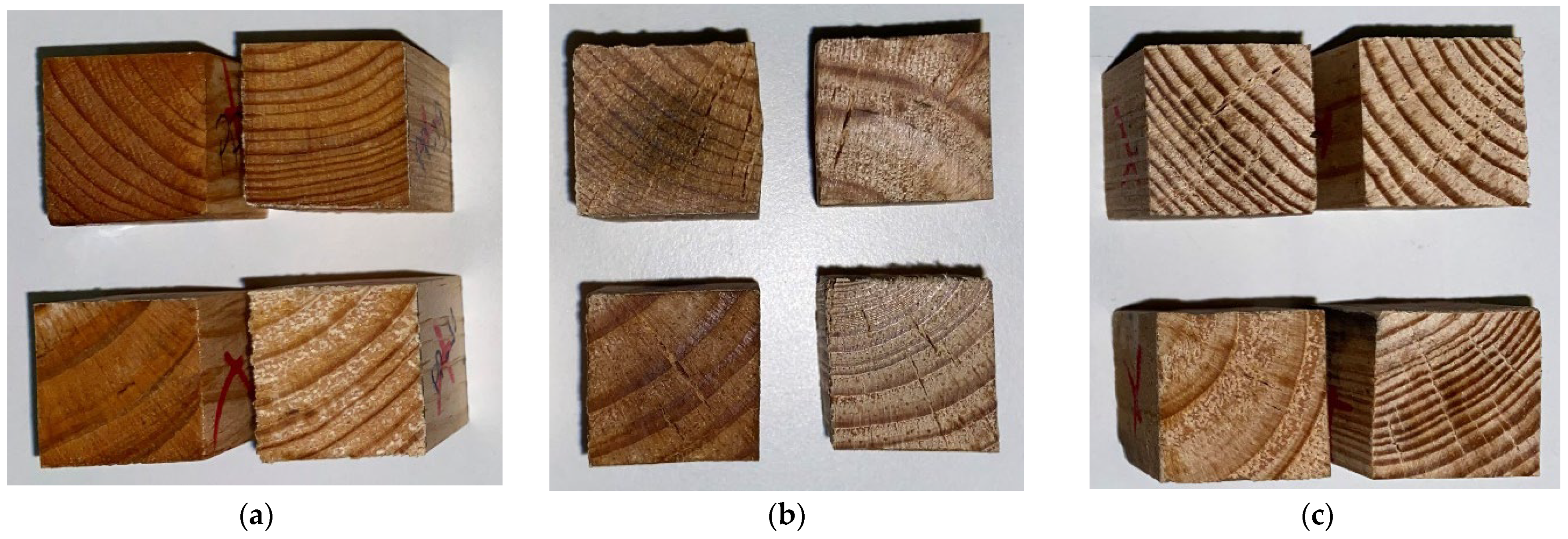
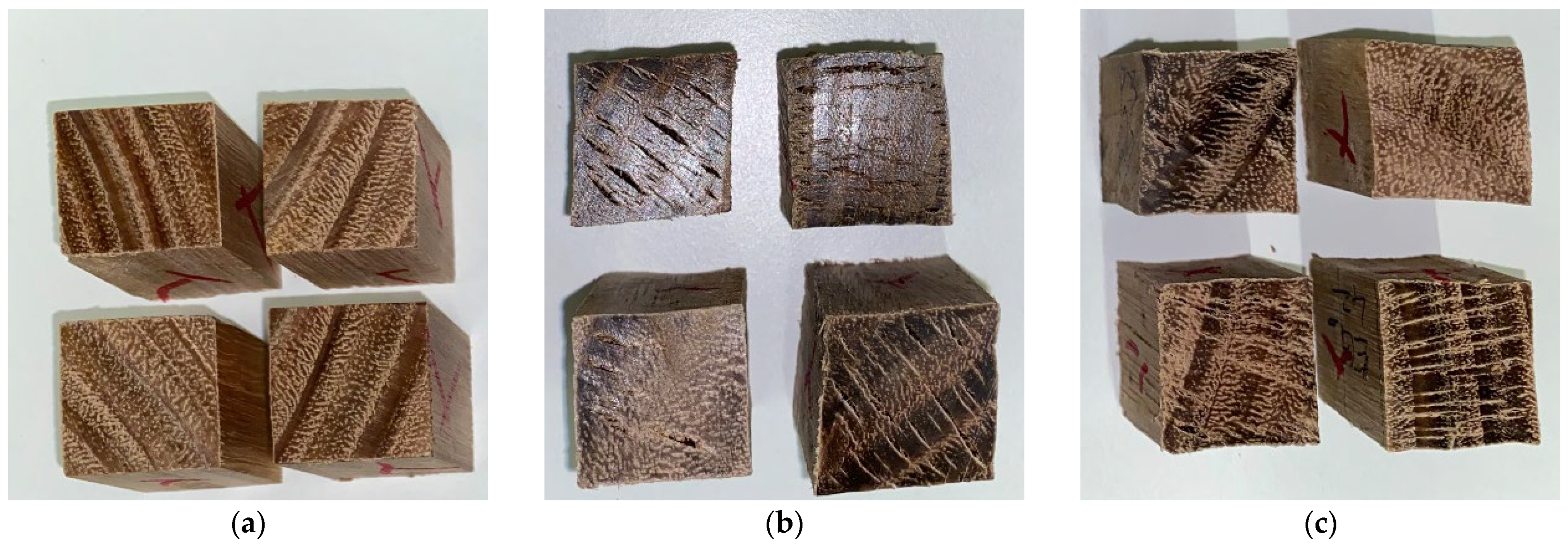
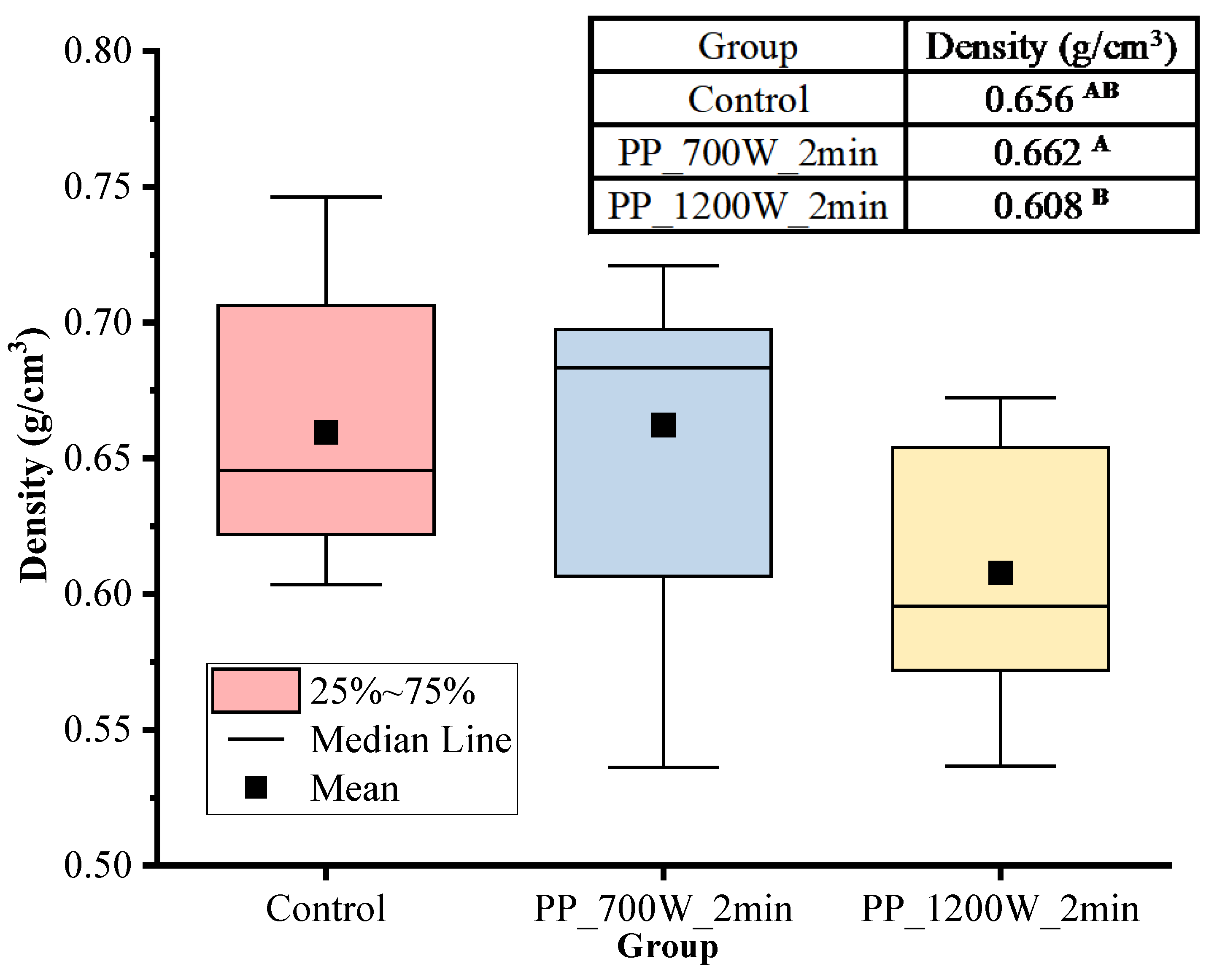

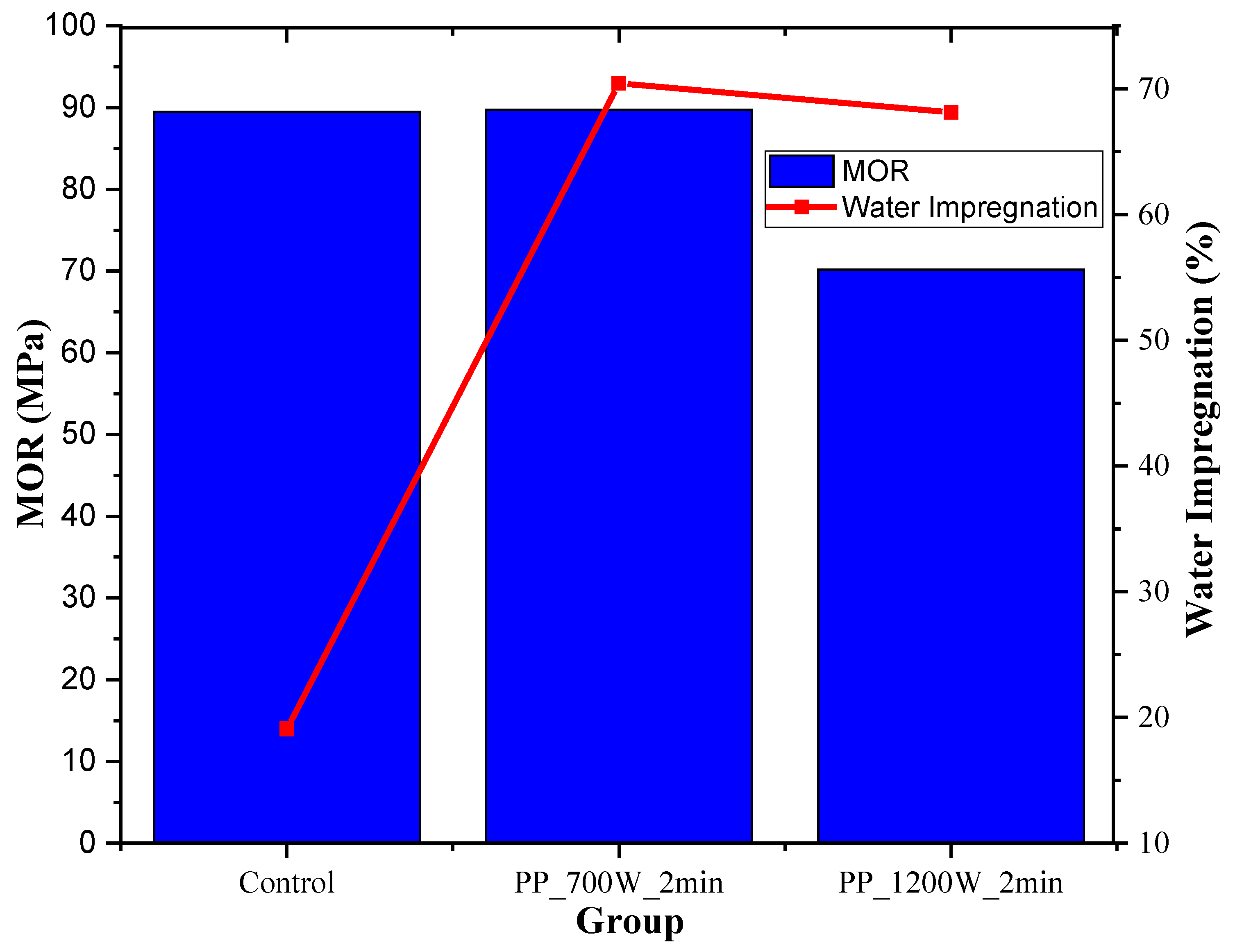
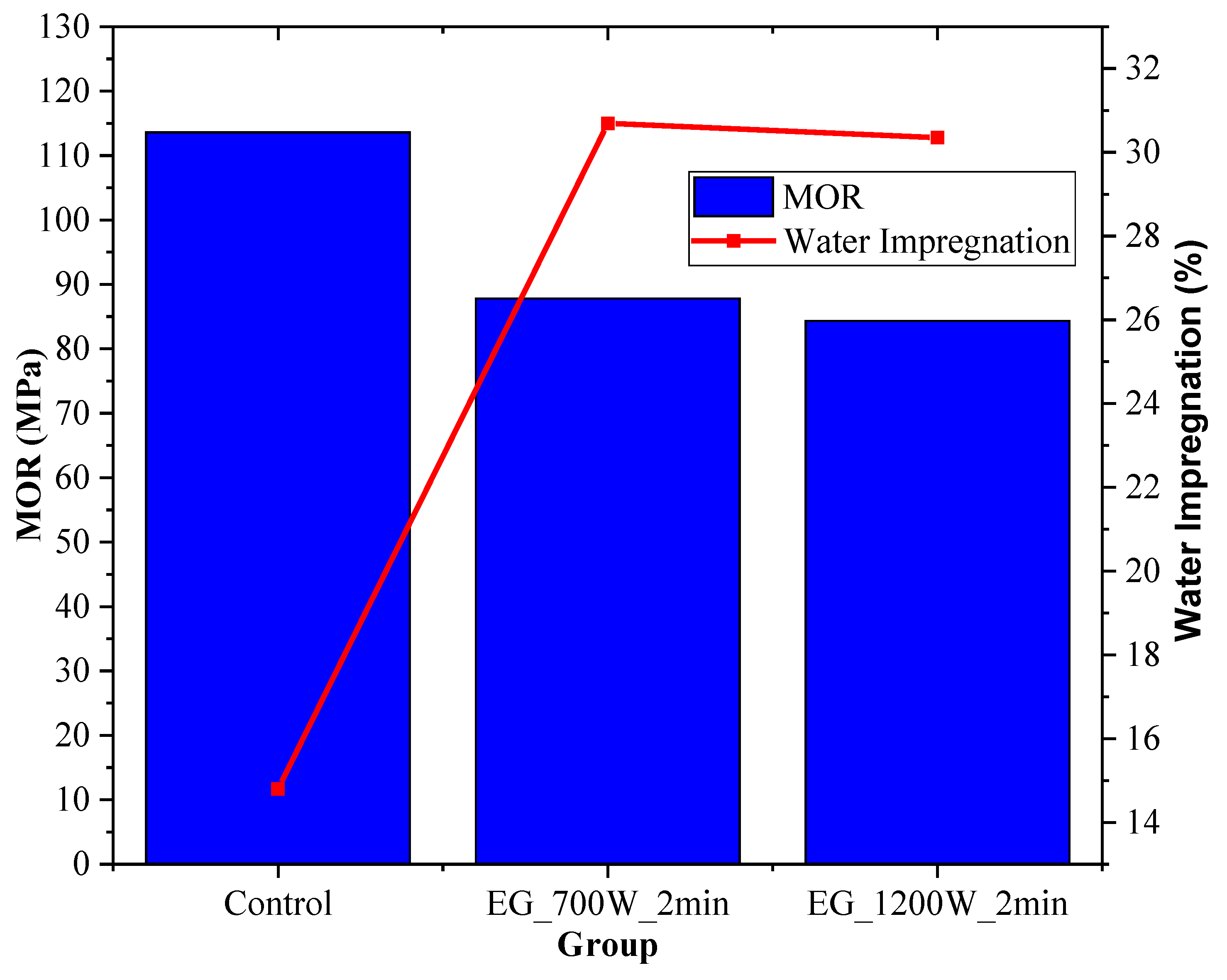
| Group | Quantity | Initial MC (%) | MW Power (W) |
|---|---|---|---|
| Control | 12 | 11.6 (2.3) * | - |
| PP_1200W_2min | 12 | 90.2 (11.6) * | 1200 |
| PP_700W_2min | 12 | 103.4 (5.5) * | 700 |
| Group | Quantity | Initial MC (%) | MW Power (W) |
|---|---|---|---|
| Control | 12 | 12.2 (1.9) * | - |
| EG_1200W_2min | 12 | 61.5 (6.4) * | 1200 |
| EG_700W_2min | 12 | 62.6 (7.4) * | 700 |
| Group | MW Power (W) | Total MW Exposure Time (s) | Average WPL (%) | |||
|---|---|---|---|---|---|---|
| PP_1200W_2min | 1200 | 1520 | 79.8 (9.5) | 1248 | 3563 | 0.35 |
| PP_700W_2min | 700 | 2080 | 89.9 (3.8) | 1397 | 2844 | 0.49 |
| Group | MW Power (W) | Total MW Exposure Time (s) | Average WPL (%) | |||
|---|---|---|---|---|---|---|
| EG_1200W_2min | 1200 | 1320 | 49.9 (1.2) | 1197 | 3094 | 0.39 |
| EG_700W_2min | 700 | 1560 | 50.2 (1.5) | 1133 | 2133 | 0.53 |
| Group | Water Uptake (%) |
|---|---|
| Control | 19.08 B (7.33) |
| PP_700W_2min | 70.42 A (13.47) |
| PP_1200W_2min | 68.13 A (9.47) |
| Group | Water Uptake (%) |
|---|---|
| Control | 14.80 B (5.98) |
| EG_700W_2min | 30.69 A (4.58) |
| EG_1200W_2min | 30.35 A (2.18) |
| Group | MOR (MPa) | Change of MOR (%) | MOE (MPa) | Change of MOE (%) |
|---|---|---|---|---|
| Control | 89.47 A (21.83) | - | 12,399 AB (2840) | - |
| PP_700W_2min | 89.72 A (23.71) | +0.28 | 14,719 A (3121) | +18.71 |
| PP_1200W_2min | 70.19 A (22.56) | −21.55 | 10,504 B (3143) | −15.28 |
| Group | MOR (MPa) | Change of MOR (%) | MOE (MPa) | Change of MOE (%) |
|---|---|---|---|---|
| Control | 113.60 A (10.26) | - | 17,690 A (2421) | - |
| EG_700W_2min | 87.83 B (23.17) | −22.68 | 14,993 B (2915) | −15.25 |
| EG_1200W_2min | 84.30 B (21.80) | −25.79 | 12,045 B (3524) | −31.91 |
| Group | MOR/Density (MPa/g/cm3) |
|---|---|
| Maritime pine | |
| Control | 136 |
| PP_1200W_2min | 115 |
| PP_700W_2min | 136 |
| Eucalyptus | |
| Control | 122 |
| EG_1200W_2min | 107 |
| EG_700W_2min | 101 |
Disclaimer/Publisher’s Note: The statements, opinions and data contained in all publications are solely those of the individual author(s) and contributor(s) and not of MDPI and/or the editor(s). MDPI and/or the editor(s) disclaim responsibility for any injury to people or property resulting from any ideas, methods, instructions or products referred to in the content. |
© 2023 by the authors. Licensee MDPI, Basel, Switzerland. This article is an open access article distributed under the terms and conditions of the Creative Commons Attribution (CC BY) license (https://creativecommons.org/licenses/by/4.0/).
Share and Cite
Mascarenhas, F.J.R.; Dias, A.M.P.G.; Christoforo, A.L.; Simões, R.M.d.S.; Cunha, A.E.P. Microwave Treatments and Their Effects on Selected Properties of Portuguese Pinus pinaster Aiton. and Eucalyptus globulus Labill. Wood. Forests 2023, 14, 1671. https://doi.org/10.3390/f14081671
Mascarenhas FJR, Dias AMPG, Christoforo AL, Simões RMdS, Cunha AEP. Microwave Treatments and Their Effects on Selected Properties of Portuguese Pinus pinaster Aiton. and Eucalyptus globulus Labill. Wood. Forests. 2023; 14(8):1671. https://doi.org/10.3390/f14081671
Chicago/Turabian StyleMascarenhas, Fernando Júnior Resende, Alfredo Manuel Pereira Geraldes Dias, André Luis Christoforo, Rogério Manuel dos Santos Simões, and André Eduardo Palos Cunha. 2023. "Microwave Treatments and Their Effects on Selected Properties of Portuguese Pinus pinaster Aiton. and Eucalyptus globulus Labill. Wood" Forests 14, no. 8: 1671. https://doi.org/10.3390/f14081671
APA StyleMascarenhas, F. J. R., Dias, A. M. P. G., Christoforo, A. L., Simões, R. M. d. S., & Cunha, A. E. P. (2023). Microwave Treatments and Their Effects on Selected Properties of Portuguese Pinus pinaster Aiton. and Eucalyptus globulus Labill. Wood. Forests, 14(8), 1671. https://doi.org/10.3390/f14081671







